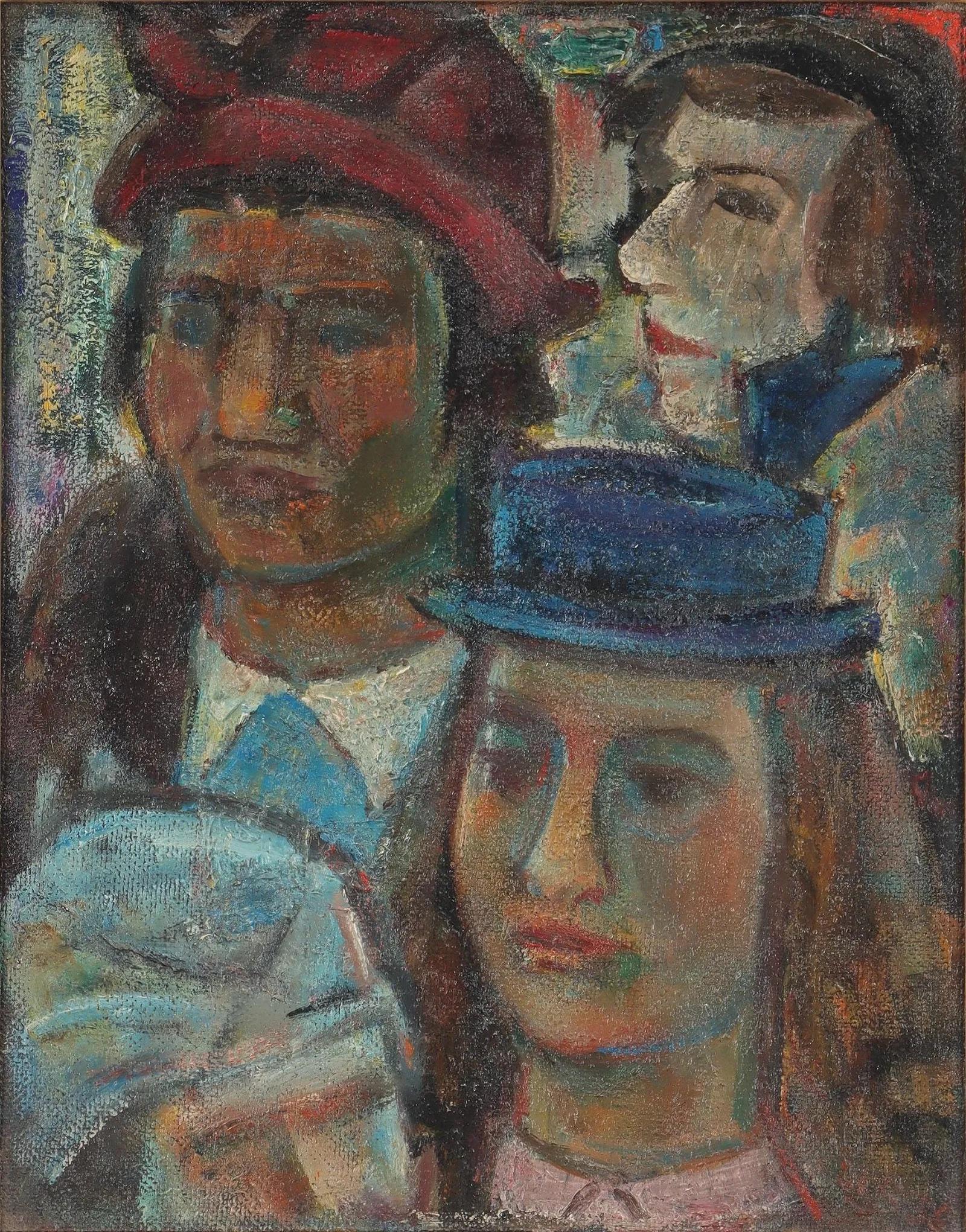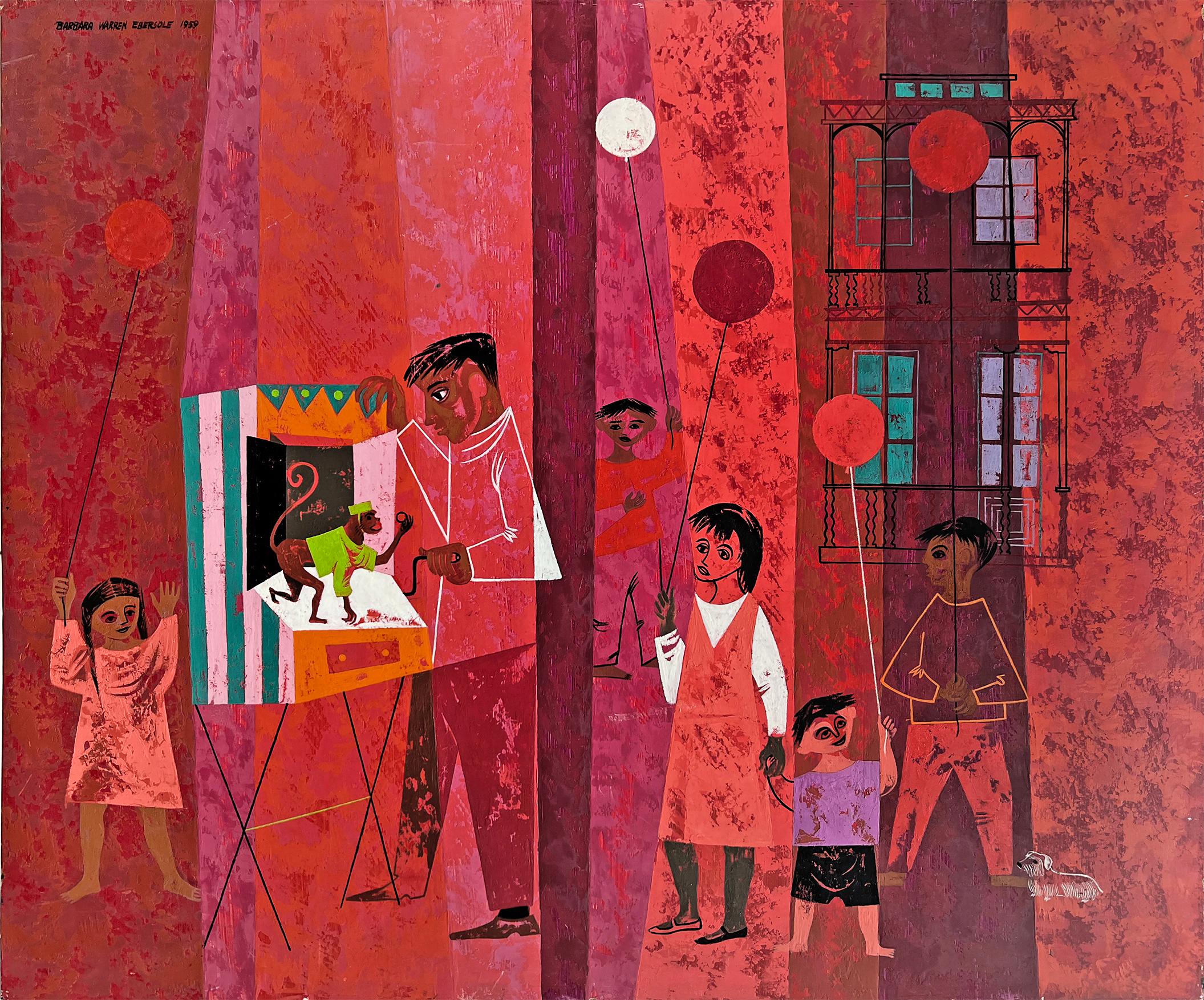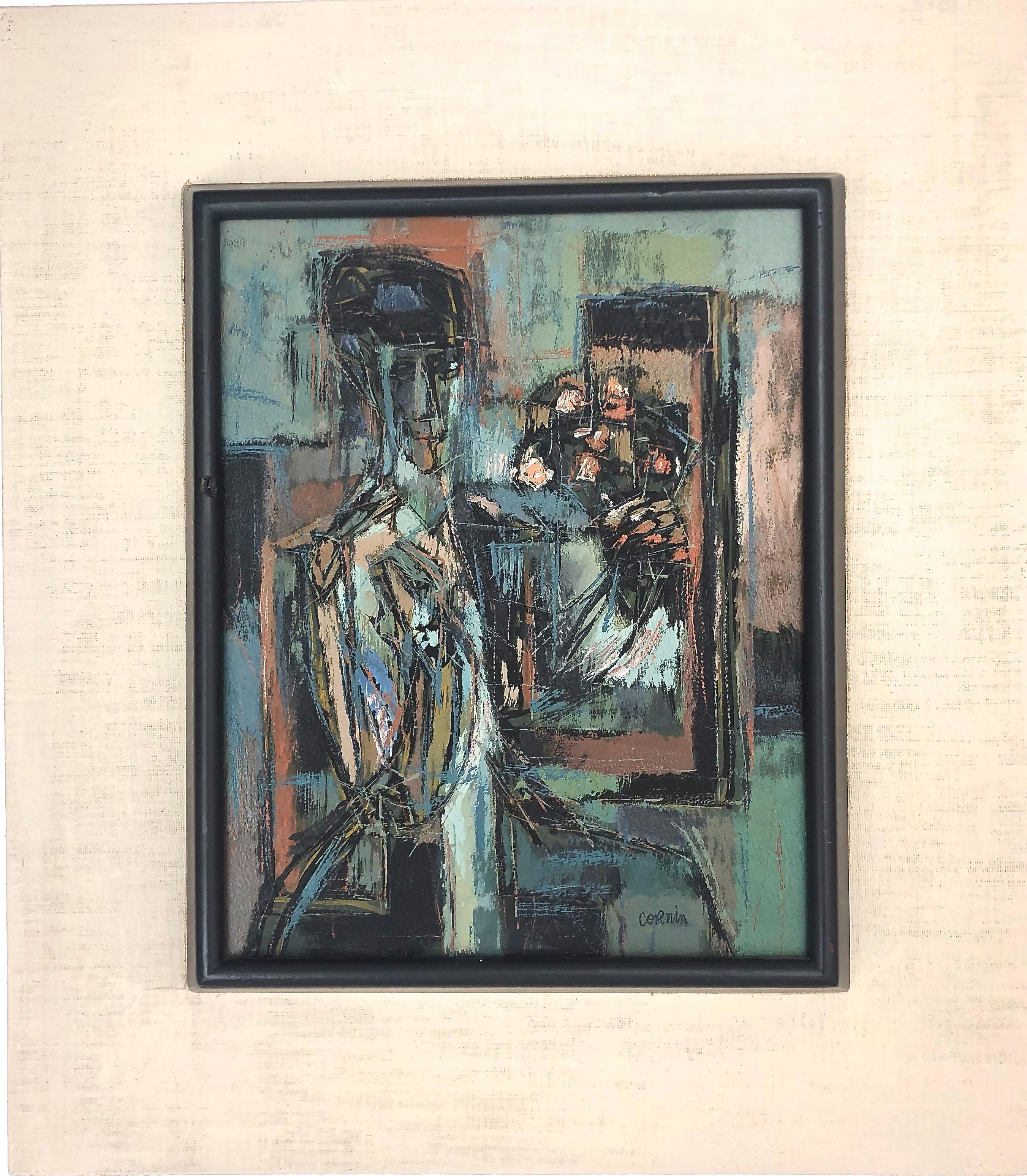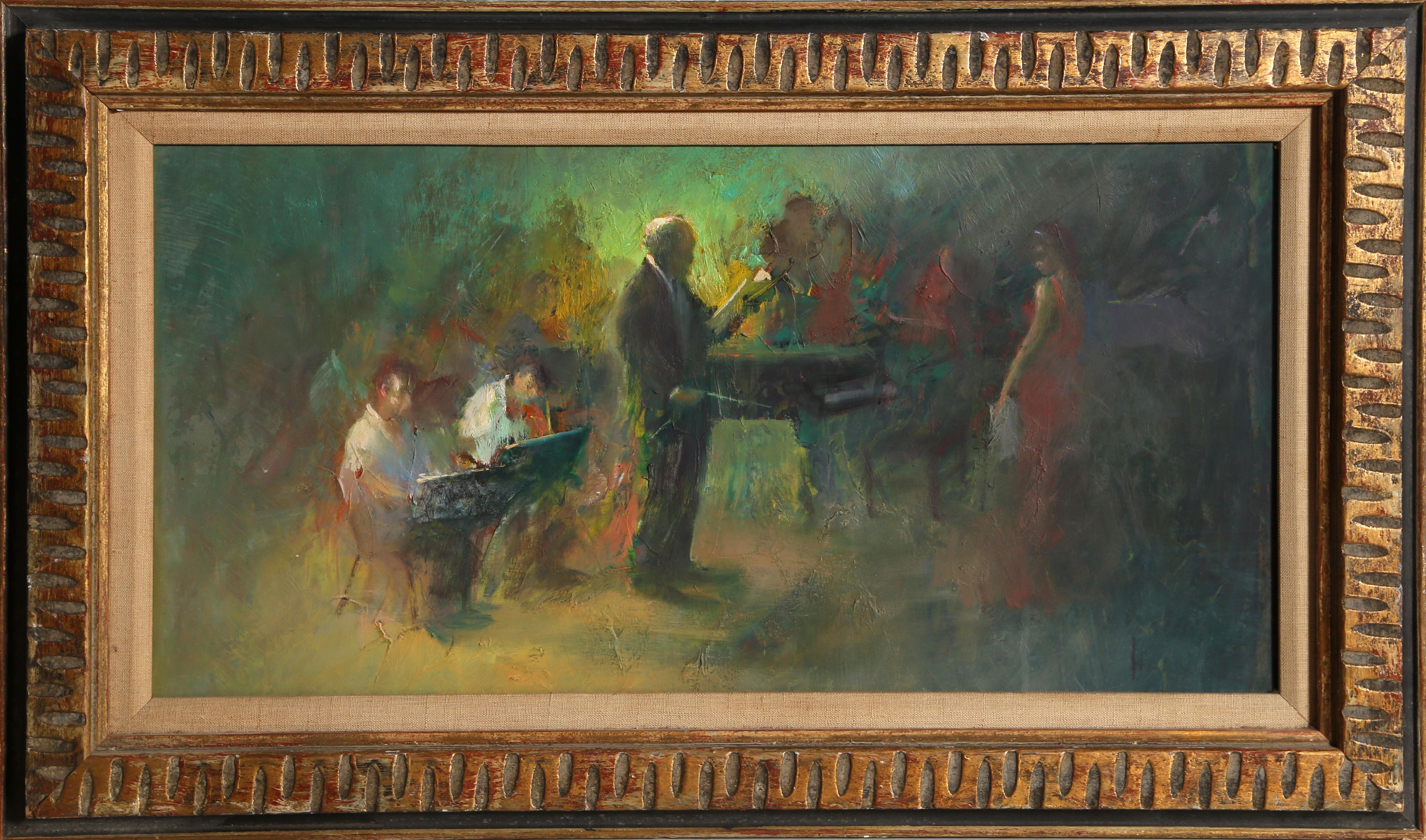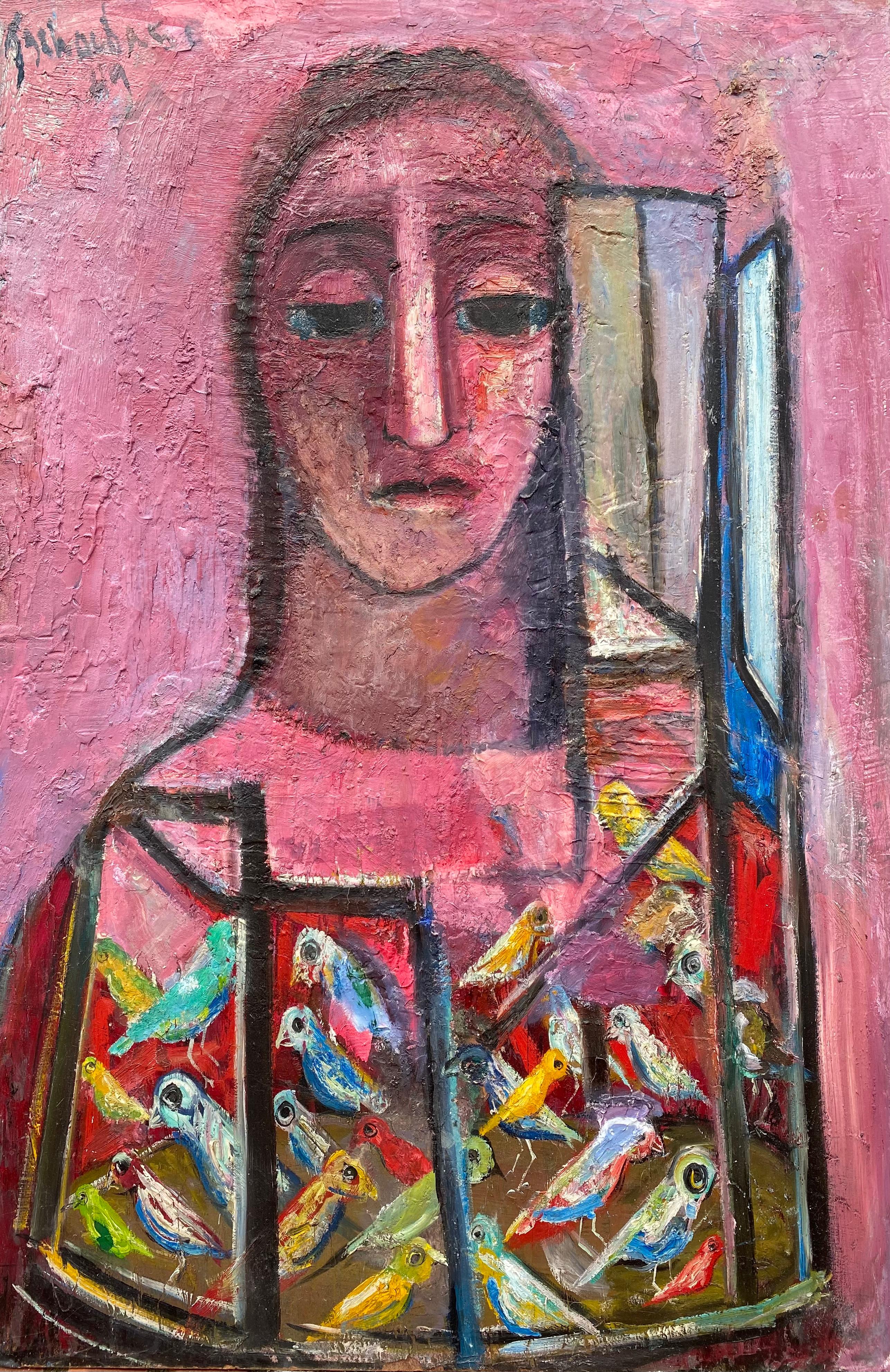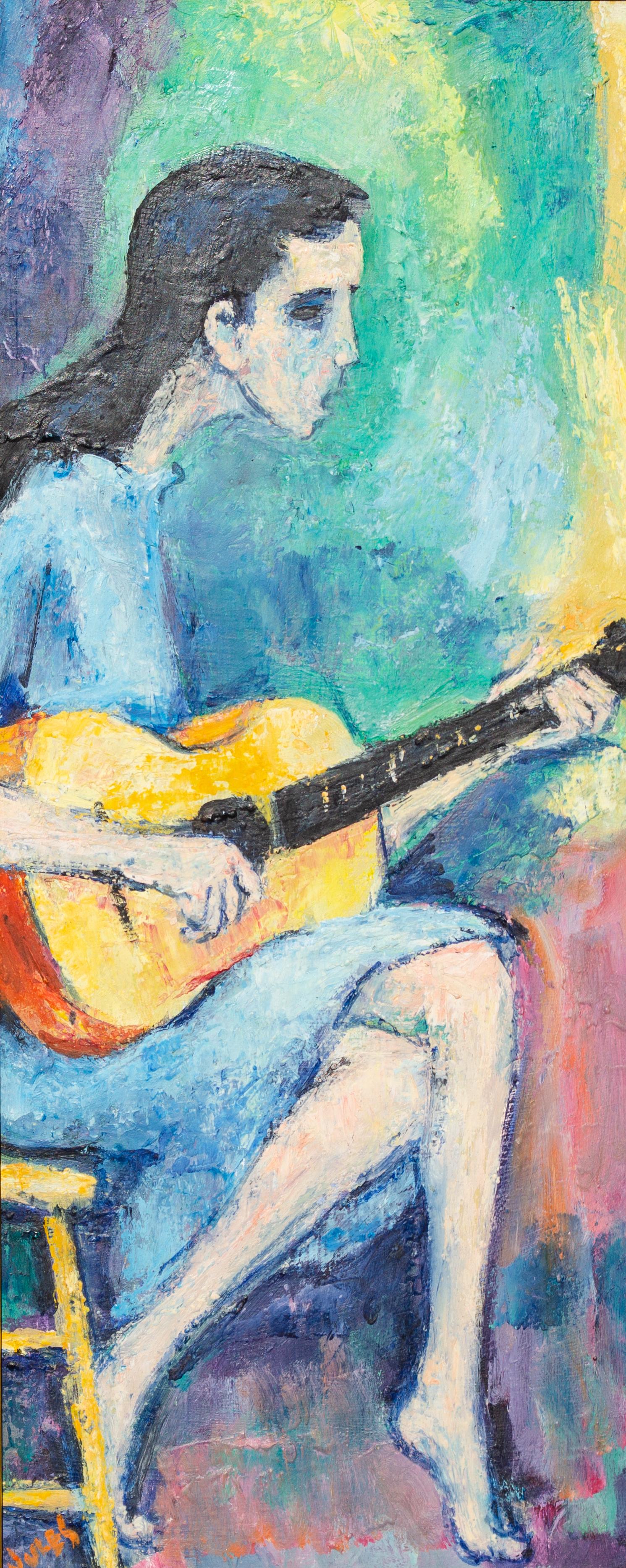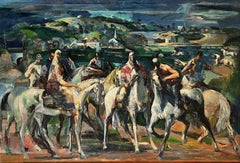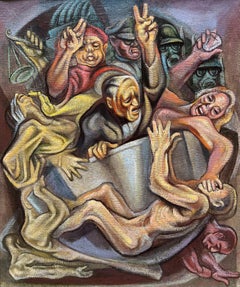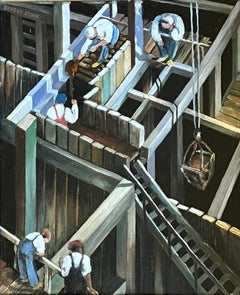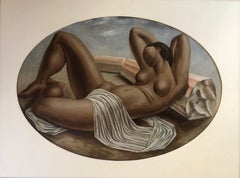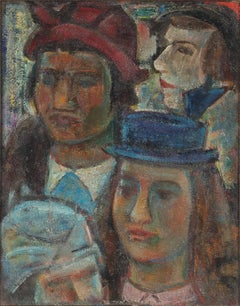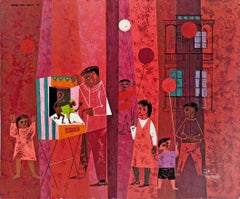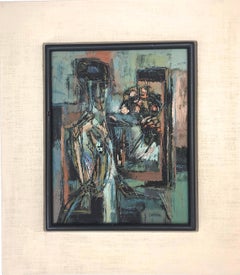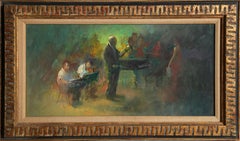Items Similar to Fallen Comrades/Interlude
Want more images or videos?
Request additional images or videos from the seller
1 of 4
Edward BibermanFallen Comrades/Interlude1949
1949
About the Item
This work is part of our exhibition - America Coast to Coast: Artists of the 1940s
Fallen Comrades/Interlude, 1949, oil on masonite, signed lower left, 35 x 56 inches; Gallery Z label verso; exhibited at 1) the Sixty-Ninth Annual Oil, Tempera and Sculpture Exhibition of the San Francisco Art Association Annual Exhibition, 1950 (partial label verso); and 2) ”Resonating Images 1900-1950” William Rolland Gallery of Fine Art, California Lurtheran University, Thousand Oaks, CA, from October 27, 2012 to February, 2013; illustrated in i) Edward Biberman, The Best Untold: A Book of Paintings by Edward Biberman, The Blue Heron Press, New York (1953), unpaginated; and ii) (film) Kaufman, Jeffrey, Brush with Life: The Art of Being Edward Biberman, 2007, (DVD release 2010), 85 minutes, presented in its original frame
Fallen Comrades/Interlude is a large rare Social Realist work reflecting the labor and political struggles of the late 1940s. Biberman and his family were committed Progressives. Soon after World War II, at the outset of the “Red Scare” in Hollywood, Biberman’s brother, Herbert, was called before the House Un-American Activities Committee and interrogated about his and others’ involvement with the Communist Party. Refusing to respond on constitutional grounds, he was held in contempt and sentenced to six months of prison. Herbert was one of ten prominent directors and screenwriters (the “Hollywood Ten”) imprisoned and subsequently blacklisted by the film industry. His conviction had a dramatic impact on the entire Biberman clan. Herbert’s wife, Gale Sondergaard, who had been one of the leading ladies in Hollywood, was also blacklisted, and galleries and institutions became reluctant to show Edward’s work.
Edward Biberman was born in Philadelphia, the son of Ukrainian Jewish immigrants. His artistic career started at the Pennsylvania Academy of Fine Arts followed by three years of study in Paris, where he associated closely with Calder and Noguchi and exhibited at the Salon d'Automne, Grand Palais, in 1927 and the Salon des Independents in 1929. Upon his return to the United States, Biberman lived in New York City, where he showed at many of the city’s premier galleries and museums. His works were selected for several of the Museum of Modern Art’s early exhibitions of American artists, including 46 Painters and Sculptors Under the Age of 35 (1930) and Murals by American Painters and Photographers (1932). Hoping to escape the pressures of the New York art world, Biberman moved to Los Angeles in 1936 where he could be close to his family, including his film director brother, Herbert Biberman, and his sister-in-law, the Academy Award winning actress, Gale Sondergaard. Although he continued to paint and show his work professionally until his death, Biberman’s relocation to Southern California and his devotion to progressive politics no doubt slowed the recognition he deserved and has received since his death.
During the course of his long career, Biberman showed at the Salon d’Automne (Paris); Whitney Museum; Metropolitan Museum of Art, Corcoran Gallery, Los Angeles County Museum of Art (LACMA) and dozens of other museums and galleries across the US and in Europe. Biberman completed three murals for public works projects, including his work Abbot Kinney and the Story of Venice for the Venice Post Office, which was installed for six months at LACMA in 2014. His works are in the permanent collections of more than a dozen museums, including the Museum of Fine Arts, Houston, National Portrait Gallery (of the Smithsonian Institution), Butler Institute of American Art, Pennsylvania Academy of Fine Arts and LACMA. Several books are dedicated to Biberman’s art, as is a feature length documentary, Brush with Life: The Art of Being Edward Biberman (2007).
Biberman’s art has undergone a resurgence of popularity during the past fifteen years with four solo or focused exhibitions, Edward Biberman Revisited (2009), Edward Biberman (2011-12), Lost Horizons: Mural Dreams of Edward Biberman (2014) and Edward Biberman, Abbot Kinney and the Story of Venice (2014), and representation in a number of other exhibitions, such as To Make a World: George Ault and 1940s America at the Smithsonian Institution and other institutions (2011), Pacific Standard Time (2012), Contraption: Rediscovering California Jewish Artists (2018), Black American Portraits (2021) at LACMA, Alone Together: Encounters in American Realism (2022) at the Westmoreland Museum of American Art and Art for the People: WPA-Era Paintings from the Dijkstra Collection (2023 - 24) at the Crocker Art Museum, the Oceanside Museum of Art and the Huntington Library, Art Museum and Botanical Gardens.
Biberman’s brand of modernism can fairly be divided into four categories 1) precisionist urban scenes of New York and Southern California which celebrate the creations of man; 2) portraits which expose not only the historical context, but also the souls, of his subjects; 3) rural landscapes and still life paintings which portray the beauty of America and its flora; and 4) social realist works which explore the struggles, hopes and shortcomings of our society. Regardless of genre, Biberman had a unique sense of structure and color. His figures are at the same time specific and universal. Taken as a whole, Biberman’s body of work presents the viewer with a compelling and often daring vision of 20th century America and its art.
- Creator:Edward Biberman (1904 - 1986)
- Creation Year:1949
- Dimensions:Height: 56 in (142.24 cm)Width: 35 in (88.9 cm)Depth: 3 in (7.62 cm)
- Medium:
- Movement & Style:
- Period:
- Condition:
- Gallery Location:Los Angeles, CA
- Reference Number:1stDibs: LU1859214266852
About the Seller
5.0
Gold Seller
Premium sellers maintaining a 4.3+ rating and 24-hour response times
1stDibs seller since 2022
14 sales on 1stDibs
Typical response time: 14 hours
- ShippingRetrieving quote...Shipping from: Los Angeles, CA
- Return Policy
Authenticity Guarantee
In the unlikely event there’s an issue with an item’s authenticity, contact us within 1 year for a full refund. DetailsMoney-Back Guarantee
If your item is not as described, is damaged in transit, or does not arrive, contact us within 7 days for a full refund. Details24-Hour Cancellation
You have a 24-hour grace period in which to reconsider your purchase, with no questions asked.Vetted Professional Sellers
Our world-class sellers must adhere to strict standards for service and quality, maintaining the integrity of our listings.Price-Match Guarantee
If you find that a seller listed the same item for a lower price elsewhere, we’ll match it.Trusted Global Delivery
Our best-in-class carrier network provides specialized shipping options worldwide, including custom delivery.More From This Seller
View AllRiders of Pigeon Hill
By Jon Corbino
Located in Los Angeles, CA
Riders of Pigeon Hill, c. 1940s, oil on canvas, signed lower right, 24 x 36 inches, label verso with title, artist’s name and address; same information inscribed verso; ex-collection...
Category
1940s American Modern Paintings
Materials
Canvas, Oil
The Demagogue or Tale in a Tub
Located in Los Angeles, CA
The Demagogue or Tale in a Tub, 1952, oil on canvas, 24 x 20 inches, signed, titled, and dated verso, presented in a newer frame
The Demagogue is an iconic Bendor Mark painting fro...
Category
1950s American Modern Figurative Paintings
Materials
Canvas, Oil
Subway Construction
Located in Los Angeles, CA
This painting is part of our exhibition American Coast to Coast: Artists of the 1930s
Subway Construction, c. 1928, oil on board, 19 x 15 ¾ inches, signed upper left, artist and title verso; exhibited: 1) 12th Annual Exhibition of the Society of Independent Artists, The Waldorf Astoria, New York NY, from March 9 to April 1, 1928, no. 864 (original price $250) (see Death Prevailing Theme of Artists in Weird Exhibits, The Gazette (Montreal, Quebec, Canada), March 8, 1928); 2) Boston Tercentenary Exhibition Fine Arts and Crafts Exhibition, Horticultural Hall, Boston MA, July, 1930, no. 108 (honorable mention - noted verso); 3) 38th Annual Exhibition of American Art, Cincinnati Art Museum, Cincinnati, OH, June, 1931 (see Alexander, Mary, The Week in Art Circles, The Cincinnati Enquirer, June 7, 1931); and 4) National Art Week Exhibition [Group Show], Montross Gallery, New York, New York, December, 1940 (see Devree, Howard, Brief Comment on Some Recently Opened Exhibitions in the Galleries, The New York Times, December 1, 1940)
About the Painting
Ernest Stock’s Subway Construction depicts the excavation of New York’s 8th Avenue line, which was the first completed section of the city-operated Independent Subway System (IND). The groundbreaking ceremony was in 1925, but the line did not open until 1932, placing Stock’s painting in the middle of the construction effort. The 8th Avenue line was primarily constructed using the “cut and cover” method in which the streets above the line were dug up, infrastructure was built from the surface level down, the resulting holes were filled, and the streets reconstructed. While many artists of the 1920s were fascinated with the upward thrust of New York’s exploding skyline as architects and developers sought to erect ever higher buildings, Stock turned his attention to the engineering marvels which were taking place below ground. In Subway Construction, Stock depicts workers removing the earth beneath the street and building scaffolding and other support structures to allow concrete to be poured. Light and shadow fall across the x-shaped grid pattern formed by the wooden beams and planks. It is no surprise that critics reviewing the painting commented on Stock’s use of an “interesting pattern” to form a painting that is “clever and well designed.”
About the Artist
Ernest Richard Stock was an award-winning painter, print maker, muralist, and commercial artist. He was born in Bristol, England and was educated at the prestigious Bristol Grammar School. During World War I, Stock joined the British Royal Air Flying Corps in Canada and served in France as a pilot where he was wounded. After the war, he immigrated to the United States and joined the firm of Mack, Jenny, and Tyler, where he further honed his architectural and decorative painting skills. During the 1920s, Stock often traveled back and forth between the US and Europe. He was twice married, including to the American author, Katherine Anne Porter. Starting in the mid-1920s, Stock began to exhibit his artwork professionally, including at London’s Beaux Arts Gallery, the Society of Independent Artists, the Salons of America, the Cincinnati Art Museum, the Whitney Studio and various locations in the Northeast. Critics often praised the strong design sensibility in Stock’s paintings. Stock was a commercial illustrator for a handful of published books and during World War II, he worked in the Stratford Connecticut...
Category
1920s American Modern Figurative Paintings
Materials
Oil
Nude with Drape
By Fletcher Martin
Located in Los Angeles, CA
Nude with Drape, c. 1937, oil on board, 24 x 17 (oval), signed lower right, provenance: Frances Lee Kent Falcone Family Trust
About the Painting
Fletcher Martin’s Nude with Drape ...
Category
1930s American Modern Figurative Paintings
Materials
Oil
Six O'Clock
Located in Los Angeles, CA
Six O-Clock, c. 1942, oil on canvas, 30 x 20 inches, signed and titled several times verso of frame and stretcher (perhaps by another hand), marked “Rehn” several times on frame (for the Frank K. M. Rehn Galleries in New York City, who represented Craig at the time); Exhibited: 1) 18th Biennial Exhibition of Contemporary American Oil Paintings from March 21 to May 2, 1943 at The Corcoran Gallery of Art in Washington, D.C. #87, original price $450 (per catalog) (exhibition label verso), 2) Craig’s one-man show at the Frank K. M. Rehn Galleries, New York City, from October 26 to November 14, 1942, #10 (original price listed as $350); and 3) Exhibition of thirty paintings sponsored by the Harrisburg Art Association at the State Museum of Pennsylvania in Harrisburg in March, 1944 (concerning this exhibit, Penelope Redd of The Evening News (Harrisburg, Pennsylvania) wrote: “Other paintings that have overtones of superrealism inherent in the subjects include Tom Craig’s California nocturne, ‘Six O’Clock,’ two figures moving through the twilight . . . .” March 6, 1944, p. 13); another label verso from The Museum of Art of Toledo (Ohio): original frame: Provenance includes George Stern Gallery, Los Angeles, CA
About the Painting
Long before Chris Burden’s iconic installation outside of the Los Angeles County Museum of Art, Urban Light, another artist, Tom Craig, made Southern California streetlights the subject of one of his early 1940s paintings. Consisting of dozens of recycled streetlights from the 1920s and 1930s forming a classical colonnade at the museum’s entrance, Burden’s Urban Light has become a symbol of Los Angeles. For Burden, the streetlights represent what constitutes an advanced society, something “safe after dark and beautiful to behold.” It seems that Craig is playing on the same theme in Six O-Clock. Although we see two hunched figures trudging along the sidewalk at the end of a long day, the real stars of this painting are the streetlights which brighten the twilight and silhouette another iconic symbol of Los Angeles, the palm trees in the distance. Mountains in the background and the distant view of a suburban neighborhood join the streetlights and palm trees as classic subject matter for a California Scene painting, but Craig gives us a twist by depicting the scene not as a sun-drenched natural expanse. Rather, Craig uses thin layers of oil paint, mimicking the watercolor technique for which he is most famous, to show us the twinkling beauty of manmade light and the safety it affords. Although Southern California is a land of natural wonders, the interventions of humanity are already everywhere in Los Angeles and as one critic noted, the resulting painting has an air of “superrealism.”
About the Artist
Thomas Theodore Craig was a well-known fixture in the Southern California art scene. He was born in Upland California. Craig graduated with a degree in botany from Pomona College and studied painting at Pamona and the Chouinard Art School with Stanton MacDonald-Wright and Barse Miller among others. He became close friends with fellow artist Milford Zornes...
Category
1940s American Modern Landscape Paintings
Materials
Canvas, Oil
$12,500
Street Cleaners
Located in Los Angeles, CA
This painting is part of our exhibition America Coast to Coast: Artists of the 1930s
Street Cleaners, c. 1940s, oil on canvas, signed lower right, 28 ¾ x 42 inches, Gallery Z...
Category
1940s American Modern Figurative Paintings
Materials
Oil
Price Upon Request
You May Also Like
Neon Lighting WPA Mid 20th Century Social Realism American Scene Modern Figures
By Maurice Becker
Located in New York, NY
Neon Lighting WPA Mid 20th Century Social Realism American Scene Modern Figures
MAURICE BECKER (1889-1975)
'Neon Lighting
17 1/4 x 13 3/4 inches
Oil on masonite
Signed, dated 1936 and titled on verso
BIO
Maurice Becker, painter, political cartoonist and social reformer, was born in 1889 either in Gorky or Niznij Novgorod, in Russia. His family came to the United States in 1892, to New York City. After high school, Becker worked in a clothing factory. He studied with Ash Can School artist Robert Henri in 1908, and exhibited in the famous 1913 Armory Show in New York City when he was only twenty-four years of age.
At the Armory show, Becker showed a drawing of a dog's head...
Category
1930s American Modern Figurative Paintings
Materials
Masonite, Oil
Mid-Century Children's Party Scene . Red and Orange, Native American
Located in Miami, FL
Broad areas of bold, flat red, magenta, and pink characterize this mid-century painting by Barbara Warren Ebersole ( Barbara Tate Ebersole ). It depicts a block party festooned with balloons and a street organ grinder with a smartly dressed performing monkey. The overall look of a lot mid-century art inspires many of today's most celebrated contemporary artists. Signed and dated upper left. Oil on Masonite. Barbara Warren Ebersole was a painter and an author. She may have been of Native American...
Category
1950s American Modern Figurative Paintings
Materials
Masonite, Oil
Pensive With Nosegay Mid Century Modern Oil Painting
Located in Lake Worth Beach, FL
Pensive with nosegay -
Painted in Berkeley CA. painting size 10x8 with frame 16x14x1
Jon (Corka) Cornin 1905-1992
Born in New York City on March 24, 1905, Jon Cornin studied in Ne...
Category
1950s American Modern Figurative Paintings
Materials
Masonite, Oil
Conductor and Singer, Figurative Oil Painting by William Harnden
By William Harnden
Located in Long Island City, NY
Artist: William Harnden, American (1920 - 1983)
Title: Conductor with Singer
Medium: Oil on Masonite, signed
Image Size: 11.5 x 23.5 inches
Frame Size: 17.5 x 30 inches
Category
1950s American Modern Figurative Paintings
Materials
Masonite, Oil
“Woman and Birds”
By Nahum Tschacbasov
Located in Southampton, NY
Mid-century oil on masonite modern painting by the well known Russian/American artist, Nahum Tschacbasov. Signed top left and dated 1949. Titled verso. Condition is fair. Provenanc...
Category
1940s American Modern Figurative Paintings
Materials
Masonite, Oil
$4,600 Sale Price
20% Off
Mervin Jules Folk Singer Portrait, Signed
By Mervin Jules
Located in New York, NY
Mervin Jules (American, 1912-1994)
Folk Singer, 20th century
Oil on masonite
18 x 7 1/2 in.
Signed lower left: Jules
Provenance: Garelick's Gallery, Detroit
Matte included, no fram...
Category
20th Century American Modern Figurative Paintings
Materials
Masonite, Oil
Recently Viewed
View AllMore Ways To Browse
Edward A Best
Communist Painting
Large Painting Party
Prison Painting
Philadelphia Ten Art
Edward Hoper
Huntington Oil Painting
Un American A Paris
Art American Post Realism
Californian Botanical Art
Framed Vintage Botanical Art
California Oak Painting
Garden Party Painting
Wpa Era Paintings
A Galion
Live Oak Painting
Wpa Art California
Noguchi Signed
